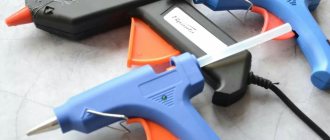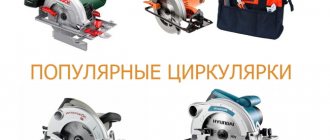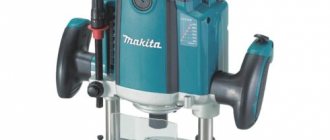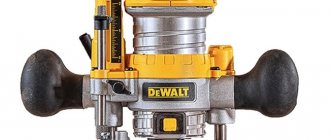Do you like to create furniture with your own hands, make a staircase in your house, decorate your house or bathhouse with curly trim? In this case, it will be difficult to do without a lamella or key router.
What is this device and what is it for? A key router cuts linear grooves into a piece of wood to install keys or lamellas. The method of connecting wooden parts using lamellas (oval-shaped wooden parts) gives reliability and strength to the entire structure.
Frames, tables, chairs, cabinets made by your own hands will delight not only the home craftsman with their individuality, but also all those who touch them.
Peculiarities
The design of a manual lamellar router is very similar to a grinder.
Only the cutting part of the tool moves parallel to the sole during milling.
The body itself slides in a horizontal plane.
In order to cut a groove for the lamella, a disk cutter is used.
Main details of the lamellar (keyway) router:
- Power unit (electric motor);
- Cone-shaped gearbox;
- Disc cutter;
- Frame ;
- Cord with plug;
- Cast platform;
- Rubberized handle;
- Bag for chips and dust.
Depending on the power of the power unit, milling cutters are divided into three types:
- Small 750 W - for hobbyists who use the tool to make single products.
- Medium 1100 W - used for the production of small batches of furniture.
- Powerful from 1200 W - professional equipment designed for full-time work. They are in demand in small furniture manufacturing industries.
In large factories with mass production of furniture units, stationary type milling machines are installed.
Let's describe the principle of operation of a lamellar milling cutter in a nutshell - rotational torque is transmitted from the engine through the gearbox to the cutter. The cutter itself is securely fixed to the shaft. The casing protects hands and foreign objects from getting into the cutting area. The cast platform allows the milling tool to be securely mounted on the surface in which the groove is being made. The rubberized handle makes it easy to use and press down if necessary.
The milling process produces fine wood chips and dust. It not only gets clogged into the mechanism itself, but can also enter the nasopharynx and lungs of a person. To prevent this from happening, a bag was developed to collect dust and small chips. It does not allow clogging of mechanisms, and, accordingly, does not cause engine overheating. In some cases, the router is connected to a vacuum cleaner using adapters.
The connecting piece itself, the lamella, cannot be ignored. The lamellas for the router are oval-shaped keys. They are strictly standardized, the number is indicated on the lamella itself. They can be purchased in stores, but some amateur craftsmen make them themselves. For this, plywood or chipboard 4 mm thick is used. More elite materials are oak and cedar. The use of this expensive material is the prerogative of experienced craftsmen, who first plan a plank of oak or cedar of the required thickness, and only then make dowels from it.
Storage of the lamella requires dryness and tightness. Air humidity affects the shape of the lamellas - with high humidity they swell and do not fit into the groove. And when they overdry, the lamellas warp and either do not fit into the groove, or dangle a lot, and ultimately do not perform their functions as connecting parts.
Design and principle of operation
The operation of the tool is based on the principle of converting electrical energy from a household AC network into mechanical energy. Entering the motor, the current causes the motor rotor to rotate, which drives the disk cutter through a gearbox. Due to its rotation, a keyway is produced in the workpiece.
Structurally, the milling cutter consists of the following elements:
- frame . It is the main load-bearing element of the structure on which other elements are attached. Inside it there is an electric motor, wiring and fuses, as well as a planetary gear that transmits rotation to the milling gearbox;
- handle . Serves to hold and guide the tool along the intended cutting line;
- milling gearbox . The main working part of the tool. It is in it that the disk cutter is fixed and the process of selecting a groove for the key takes place. Some models have a protractor with a scale that allows you to change the penetration angle, as well as a sampling depth regulator.
For greater convenience, the case can be equipped with a silicone insert, which ensures a safe and reliable grip of the tool in your hand.
Advantages
The main advantage of lamella routers is the cutting of grooves for the lamellas. And such connections have a number of advantages:
- The lamellar router can be used in horizontal and vertical positions.
- Connecting elements at any given angle. Such connections are very necessary when designing furniture products. This type of connection preserves the aesthetic appearance of the furniture.
- Performing technological operations at high speed. Very relevant for serial furniture production. When using a key router and a special cutting tool together, the productivity of the technological process can be significantly increased.
- Cost-effective when performing some work. Materials selected from the grooves can be used to insulate or decorate facades.
- Comparative safety.
How to make a lamellar router yourself
In times of crisis today, a householder cannot always afford to buy a full-fledged router. Therefore, we will consider a way to get out of this situation using an ordinary grinder with a disk, several sheets of plywood or plexiglass, and, of course, your hands and ingenuity.
You can make such a tool yourself from an ordinary grinder or otherwise an angle grinder. It is desirable that it have adjustable rotor speed. This is necessary in order to be able to set the required disk rotation speed. In exceptional cases, a machine with a 125 circle diameter is suitable.
In addition, we will need a lamellar cutter. Plywood or plexiglass, which can be pre-polished, is suitable as a material for the body. The main body with side grooves consists of two side and rear walls. There are no upper and lower parts here; the grinder itself with a lamellar disk is inserted into the grooves of the side walls using guides cut out of wood, attached to it on both sides. To adjust the cutting height of the lamellas, it is necessary to construct a simple lifting device. If there is no need to adjust the height, the tool can simply be fixed at a certain height. The remaining side wall is fixed to the angle grinder using bolts screwed into the thread under the holder.
After reading this material, you can assemble such a tool yourself, spending time and effort, but saving your finances. We sincerely hope you enjoyed our article!
Hand tools of narrow specialization are used mainly for the mass production of furniture and building structures. A lamellar router simplifies the process of joining wooden elements, extending and gluing boards. A manual milling machine is designed on the principle of a grinder. It allows you to make grooves, figured trims, cut quarters in beams and perform other work without special devices.
Recommendations for selection
When planning to buy a lamellar tool, pay attention to the following main characteristics:
- Engine power. Depending on what you are going to do with a lamellar tool, it depends on what power the tool should be chosen. For a home workshop, a small lamellar machine is quite enough. A medium-power machine is needed when building a summer house, or, for example, a bathhouse or sauna. Trimming steps, connecting side panels on a staircase, terrace or balcony, creating decorative elements of the facade, cutting grooves and cutting quarters - this can be easily done with a medium-power lamellar machine.
- Possibility of adjusting the working angle. Nowadays, most modern devices have this feature, but we couldn't help but pay attention to it as it affects the functionality of the device.
- Cutter rotation speed. The cleanliness of the processing directly depends on the rotation speed of the cutter. Do not use a high-speed router for working with soft materials and wood boards. They are easy to process at low speeds.
- Clamp type for cutter (collet). The collet must be made of high quality metal. Don't buy an expensive router just because of a quality collet. It is enough to purchase a collet made of hardened steel and replace it if you are not satisfied with what is available.
- Speed adjustment. Allows you to select the mode that is necessary for processing a specific material. For hard materials (stone, brass, aluminum) fast rotation is required, but for softer ones it is not necessary.
- Blocking. Automatic protection. If there are children in the house, then blocking and automatic protection are simply necessary. In fact, this feature ensures the safety of your loved ones.
- Smooth start. Allows you to start the process of cutting grooves without sudden jerks.
- Working stroke of the milling cutter. If you need to make parts with deep longitudinal grooves, or grooves for leveling floor boards, you should pay attention to the working stroke of the lamellar cutter.
- Connecting a garbage bag. A vacuum cleaner or dust bag can be connected through the connecting elements. This ensures comfort in the workplace and safety for the health of the master.
Rating of popular models
A lamellar router is a specific tool. It is unlikely that you will be able to hold it in your hands in retail chains, since it is often supplied to order. Therefore, before purchasing, you should read the description of the most popular models, which have already been tested by experts.
Makita PJ7000
This model can be described as professional at an economy class price. The cost of this router is about 15,000 rubles. Motor power – 11000 rpm. The tool is packaged in a convenient carrying case and equipped with a large dust bag.
Advantages of the model:
- precise adjustment of the angle and height of the sole;
- quiet engine;
- convenient protective cover for the cutter.
- The disadvantages include insufficiently reliable fixation of the stop and the absence of a mesh to protect the body from sawdust.
Interskol FMS 100/710
Model costing about 10,000 rubles. Maximum speed – 9000. An excellent choice for a novice master.
Advantages of the model:
- adjustment without play;
- convenient replacement of the cutter;
- protection of the housing from debris;
- reliable fixation of the sole.
But this tool is not without its drawbacks:
- discrepancy between the sole height scale and the actual dimensions;
- body vibration, which is inconvenient during long-term work;
- increased noise during operation.
FELISATTI RF100/710
Externally it looks like the Makita PJ7000, but differs from this model in characteristics. The manufacturer positions the tool as semi-professional. But according to experts, the model cannot claim this title.
Significant disadvantages of the router:
- weak fixation of the sole stop, and therefore it is quite difficult to achieve parallelism with the plane of the cutter.
- lack of a dust collector and carrying case;
- strong noise from the gearbox, which indicates a poor fit of the gears.
The tool has some advantages : high-quality plastic body and convenient change of cutter.
Diold ShRE-0.9
Typically an amateur model, exclusively for home use. Externally, the router looks like an improved grinder. The kit includes a case, cutter and dust bag.
Advantages of the model:
- low price - about 3500 rubles;
- powerful engine that can quickly gain speed.
Disadvantages of the tool:
- rough assembly;
- too much weight;
- wedging of the guide slides.
HILDA 760
The tool is made in China, but it is well made.
Advantages of the model:
- low price - on average 4,700 rubles;
- low noise gearbox;
- no vibration of the housing during operation;
- comfortable position in the hands due to the ideally selected case diameter;
- powerful engine.
Disadvantages of the model:
- inconvenient location of the switch;
- the ruler does not correspond to the actual height of the sole.
Makita BPJ180Z
Model with battery, which is convenient for operation. The battery holds a charge for a long time. The tool speed is low (6500), but the router can handle any wood.
Disadvantages of the model:
- heavy weight due to the battery;
- inability to work directly from the network.
MAFELL LNF 20
Heavy and expensive professional tool. Its cost is on average 45,000 rubles. It is recommended to purchase such a model only if the tool will be used systematically. This router is capable of making grooves of any size, down to the smallest resin pocket.
Advantages of the router:
- perfect fit of the sole parts, which is reflected by the absence of distortions and play;
- accuracy of the measuring scale;
- convenient revolver stop;
- maximum configuration: the set includes a case, a dust collector, maintenance tools, and cleaning products.
The model has virtually no flaws. The only thing that can keep you from buying it is the high price.
With the right choice and skillful use, a lamellar router will become a reliable assistant for the home craftsman.
Care
Every time after work, the router must be cleaned of wood dust.
This can be done with a vacuum cleaner, but the dust should not be sucked in, but blown out.
Or you can clean it with a brush - carefully sweep all surfaces of the instrument, removing dust and small particles.
In case of greater contamination (dirt that has become embedded in the connecting seams between parts), it is necessary to carry out radical cleaning with special products designed for wiping electrical equipment, or with gasoline. The entire cleaning procedure must be carried out with great care, preventing liquid from getting inside the instrument body or on the on-off system. If a similar situation arises, then the router needs to be dried very well and only then used.
In more expensive models, a vacuum cleaner is connected using adapters or a bag is installed to collect dust and small sawdust.
If vibration or unusual engine sound begins to bother you, then you should first of all pay attention to bearing wear. In these tools, the bearings themselves do not need to be maintained; if they wear out, they are replaced with new ones. It is better to replace bearings in a workshop, since special tools are needed to remove the old bearing and install a new one.
What is a lamellar router for? What is a lamellar router
A lamellar router is a tool designed for cutting grooves for lamellar joints. A lamella is a standard size wooden plate. This tool is similar in design to a grinder. The main parts of which it consists are the power unit, the gearbox in the form of a cone, and the body itself. The cutter is secured to the spindle using a nut.
The tool is suitable for working with wood, as well as for plastic materials, plexiglass, stone, non-ferrous metal, but additional equipment is required. With a router you can perform the following types of work:
- edge profiling;
- quarter sample;
- grinding;
- drilling technological holes;
- cutting out recesses and slots of various shapes;
- cutting of thorns.
Different types of work require milling cutters of different power. They can be divided into three groups:
- 750 W – low power;
- 1100 W – average power;
- 1200 W – powerful.
For domestic use, it will be enough to use a milling cutter with a power of 750 or 1100 W.
The spindle speed can vary from 3000 to 24000 rpm. You should select a mode based on special tables. The milling depth ranges from 30–60 mm.
The starter in modern models usually has foolproof protection, the so-called blocker. In addition, there is a locking mechanism, without which the workflow becomes problematic.
The collet is a clamp for a cutter. It must be made of hardened steel. The cone-shaped collet is considered the best among specialists. For convenient removal of debris from the working surface of the table, dust suction is provided. The base of the router can be made of stamped metal or cast.
Types of hand routers
Plunge router
This tool has a base and two vertical arms. The cutter is directed vertically downwards. When processing, the milling cutter lowers down using pressure, and after finishing it rises back. There is a hole in the base through which the cutter can process the material. This tool allows you to drill holes, process closed contours, and round edges. This type of milling cutter also has names: vertical or rod.
Plunge routers
Edge router
Its body functions as a handle that is held with one hand. At the base of the cutter there is a stop located perpendicularly. Can be used both vertically and horizontally. During use, such a router is pressed against the workpiece with its base and the edge of the wooden part is processed. Used for creating grooves, cutting grooves or chamfering. Its device allows you to perform operations that require high precision. Such milling cutters are also called “edging router” and “trimmer”.
Edge routers
Rotary router
It is made in a narrowed body. This type of tool has a high rotation speed. It is used to create holes and make grooves. It is used not only for working with wood, but also for laminate, tiles, drywall and some other materials.
Using a rotary router, you can perform decorative processing of the material. Such devices are lightweight, which allows the master to spend less effort during the work process. An adjusting screw is provided to determine the milling depth. Some models provide protection against the spread of dust during operation.
Rotary milling machines
Lamellar router
This tool is designed to create grooves of various shapes. It is made in such a way that the body can be held in one hand. There is also a handle for the other hand. There is a stop that is located parallel to the cutter. This tool is used to process the edges of wooden parts. The cross-section of the groove created depends on the shape of the cutter.
Lamellar routers
Filler milling cutter
The main purpose of such a router is to use it to create dowel joints, which are used to connect elements when assembling furniture. They are small wooden tenons and holes for them, made on the corresponding parts for assembly.
Filler milling cutters
Characteristics
Pictured: Kress 800 FDF lamellar router.
Motor power
for both lamella and filler milling machines it is 590-800 W. Tool diameter, speed and depth
- “Lamelniks”
are equipped with a cutter with a diameter of 100 or 105 mm, which makes 9, 10 or 11 thousand revolutions per minute and plunges into the material to a depth of 20 or 22 mm. - Additive milling cutters
- their cutting equipment is replaceable, because dowels come in different diameters. You can install cutters with a “caliber” from 3 to 12 mm. The rotation speed is 18,500 rpm at idle, and the maximum milling depth is 40-43 mm.
Frequency adjustment
Lamella and filler milling cutters do not have it. These highly specialized machines simply do not need it.
Images used in this article: dewalt.ru, kress-tools.com, milwaukeetool.ru
How to do something yourself, with your own hands - home craftsman website
AN EXCELLENT TOOL FOR CRAFTS AND HANDCRAFTS AND EVERYTHING FOR THE GARDEN, HOME AND Cottage LITERALLY FOR FREE - SEE FOR YOURSELF. THERE ARE REVIEWS.
The lamellar router can rightfully be called a tool that has been unfairly ignored by many craftsmen. Many people believe that it is intended only for making grooves in wooden blanks. This is not true - this tool is much more versatile, and for those who like to make things with their own hands, it will be useful in many everyday activities.
At one time, when building a bathhouse with my own hands on a summer cottage, I decided to choose a quarter of the cranial bars with a cross-section of 50×50 mm for laying boards with a cross-section of 25×100 mm for the subfloor. This was necessary so that there would be room left for the insulation (2×50=100 mm) after installing the subfloor (photo 2) between the 150 mm high joists.
Of course, even if there is no stationary equipment in the workshop, there are many ways to select a quarter: with a hand-held circular saw, with an electric planer, with a milling machine and, finally, with a lamellar router.
The latter, unlike other tools, is very easy to configure. In addition, a cut quarter with a cross-section of approximately 22x22 mm will also be useful on the farm, and only shavings will remain from a plane or hand-held milling machine.
TOOLS FOR HOME AND GARDEN, HANDCRAFTS, ETC. PRICES VERY LOW
That's why I preferred a lamellar router. It is safer to work with it than with a circular saw, and the cut is clean. True, I had to replace the standard 100 mm saw blade with a 110 mm blade, also recommended by the tool manufacturer. Then the required cutting depth is achieved - 25 mm. And no more or less of these bars were required - almost 100 linear meters. m.
general information
The industry took care and created a unique tool for the job:
- on wood;
- plastic;
- plexiglass;
- stone;
- soft metal;
- complex composites;
- ceramics.
For master carpenters and processors of various materials, carpenters, the router has become the best find of the new century. Flooring and tile installers, as well as furniture assemblers, readily use power tools.
Such a unit allows:
- drill any hole;
- make complex and simple parts;
- make grooves;
- create elements of patterns and letters, numbers;
- process the edges of the product, parts.











